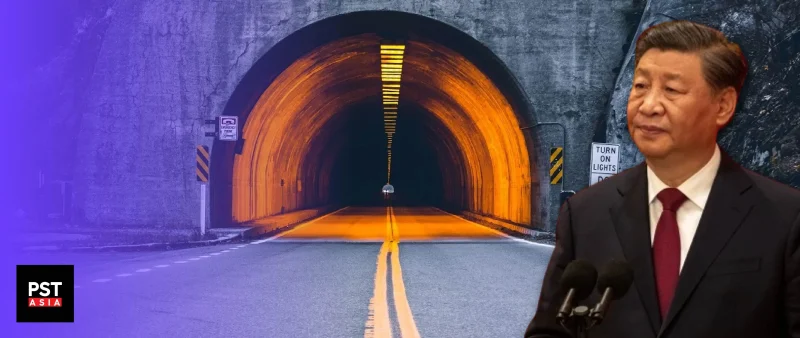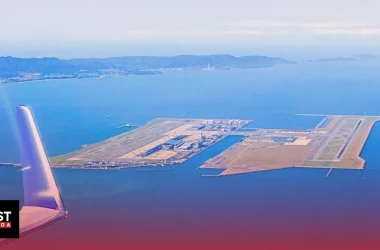As you’d expect from China, the country is once again pushing the boundaries of modern engineering. It is currently building the Tianshan Shengli tunnel, which will be the world’s largest highway tunnel at 22.1 kilometers!
This tunnel is meant to increase connectivity between China’s Xinjiang region and Central Asia, which is becoming really important for China.
It is believed to be the biggest and most difficult infrastructure project China has ever taken since it requires drilling through the Tianshan Mountains, one of the longest mountain ranges in Central Asia.
Construction is undeniably hard, but the economic benefits that this tunnel will bring are certainly worth it! It is now around 70% done and set to open in 2025. Once completed, it will mark a true engineering marvel by overcoming a massive natural barrier.
Construction in the Tianshan Mountains
This new Chinese project under construction will pass through one of the world’s longest mountain ranges and open new pathways for exchanges between the country’s Xinjiang Uygur autonomous region and Central Asia, a region that is increasingly important to China for foreign trade.
The tunnel is called the Tianshan Shengli tunnel and it is a crucial section of the Urumqi-Yuli Expressway, which is a highway traversing the Taklimakan Desert in Xinjiang that began operations in 2022.
In order to open up the Tianshan Mountains, the builders working on the tunnel faced many difficulties, such as complex geological conditions, difficult construction, and high safety risks.
It’s important to note that the tunnel is located in a high-cold and high-altitude area. There were many obstacles to the construction, such as fractures in the mountains, violent rock bursts, damage caused by freezing, fissure water, and salivary water.
The project also passes through earthquake-prone areas such as the Tianshan earthquake zone, which makes construction difficult.
Adding to the difficulties, the project also needed high ecological and environmental protection requirements. That is because the Tianshan Shengli Tunnel is close to Tianshan No. 1 Glacier and Urumqi Water Source Reserve, two locations with high environmental protection requirements.
To overcome the construction difficulties caused by extreme natural conditions, the project has strengthened safety management and innovated in construction methods.
In fact, the tunnel’s construction adopts the new “three-hole + four-shaft” construction scheme, among which the service tunnel adopts the tunnel boring machine, or TBM construction method to excavate, which is the first application of the domestic highway tunnel.
When it’s completed in 2025, the tunnel will span a total length of an impressive 22.1 kilometers or 13.7 miles, which makes it the longest currently under construction.
The Tunnel’s Benefits
The tunnel will serve as an essential transport link between the southern and northern halves of the region by cutting travel time through the Tianshan Mountains to about 20 minutes. Additionally, the journey from the capital Urumqi to Korla, the region’s two most populous cities, will be shortened from more than seven hours to about three hours.
The project will bring more trade and economic growth in an underdeveloped part of Xinjiang that has been ignored for long, and it’ll help China build stronger diplomatic and economic ties with Central Asia, an increasingly important region both as a final market and a transit point.
The Tianshan Shengli tunnel compliments the China-Kyrgyzstan-Uzbekistan railway, another infrastructure megaproject connecting China with Central Asia in order to increase regional integration. Both projects are part of China’s massive infrastructure-building campaign, the Belt and Road Initiative, or BRI.
Because it offered large loans to many developing countries and countries considered to be in financial distress, the BRI was hit by a number of defaults and bad debts. This caused China to rethink and repackage the initiative, and create a new BRI that focuses more on operating risk and investment returns.
In that sense, Central Asia provides a reasonable risk-return mix, especially with its rich energy reserves and sustainable security situation.
The tunnel is also expected to have a lot of economic benefits for Xinjiang and China as a whole, and you can clearly see that just by looking at the region’s location.
Xinjiang has a unique geographical location that gives it many advantages, one of them is sharing a border with eight countries, including Russia, Mongolia, Kazakhstan, Kyrgyzstan, Tajikistan and Pakistan, all of which are core to China’s Belt and Road Initiative.
Since the tunnel is meant to enhance transport networks with Central Asia, it’ll strengthen Xinjiang’s broader infrastructure links in the region and in turn increase trade and commerce on a regional scale.
In other words, the tunnel will increase Xinjiang’s economic influence in the region, and Beijing followed up on these plans by announcing plans to build a new free-trade hub in Xinjiang in order to transform it into a free-trade zone in five years.
As mentioned before, the tunnel is expected to reduce travel times in the region. In addition to that, it’s also expected to reduce transportation costs for businesses and individuals, making it more affordable to transport goods and services. This will make Xinjiang more competitive in the global market, and help to boost the region’s economy.
In addition to diversifying trade methods, the new pathway could also extend to further cultural and tourism exchanges. Xinjiang is home to tourist destinations like Kashgar, a city that used to be an ancient Silk Road oasis, known for its rich history, culture, and unique architecture.
It has been Beijing’s goal for a long time to enhance tourism in Xinjiang, as evident by the plan announced by the region’s tourism authorities this year, which consisted of an investment of over 700 million yuan, or $99 million over the year to develop tourism, encouraged by Beijing officials.
So far, the plan has been beneficial. From January to April this year, the region received 51.2 million tourists, an increase of 29.6% year-on-year, with the region’s total tourism revenue rising 60.6% to hit 42.64 billion yuan, or $5.45 billion.
A Statement to the West?
The tunnel also possibly serves as a statement to Western countries that developed geopolitical tensions with China over Xinjiang.
The U.S. and the European Union have both imposed sanctions and export control on the Xinjiang region in 2021 and 2022 following accusations of human rights abuses against the region’s Uyghur Muslims, spying, and support of Russia’s war in Ukraine.
As you’d expect, all accusations were denied by Beijing.
Despite the sanctions, the region’s foreign trade hit a record high of 287 billion yuan or $40.5 billion in the first ten months of 2023, a near 50% increase from a year earlier and surpassing the cumulative total for 2022 by September.
Additionally, China could be building the tunnel because it is seeking to increase its influence and presence in Central Asia in order to counter the influence of its longtime rival, the United States, in the region.
Despite the withdrawal of U.S. troops from Afghanistan in 2021, China remains wary of the United States’ involvement in Central Asia.
Anxiety still persists in Beijing about the U.S. Central Asia strategy, which was unveiled by the Trump administration in 2020. The strategy aims to “build a more stable and prosperous Central Asia that is free to pursue political, economic, and security interests with a variety of partners on its own terms” and sets that out as the “primary strategic interest” to the U.S..
In May of this year during the China-Central Asia Summit, Chinese President Xi Jinping implied that the U.S. encouraged “color revolutions” in Central Asia, which threatened Chinese interests in the region.
Clearly, Beijing’s ambitions for Xinjiang are more than just economic, and the tunnel is just one stepping stone for the troubled region’s full integration into Mainland China.
The Bottom Line
Finally, we can definitely say that this tunnel megaproject is a daring feat.
It challenges a natural barrier, one of the largest mountain chains in the world, and aims to connect China with Central Asia as part of the Belt and Road Initiative, which has opened many doors for cooperation in the region in different areas, such as trade, infrastructure and energy.
China recognizes the importance of Central Asia, this is evident by China’s pledge of 26 billion yuan, or roughly $3.8 billion, worth of financial support for the region at the China-Central Asia Summit in May.
This promise is a strategic move from China as Russia’s influence weakens in Central Asia because of its war with Ukraine, and China was quick to see this opening and capitalize on it.
Like many other BRI projects, many have questioned China’s motives for this tunnel, but that doesn’t change the fact that it’ll be an engineering wonder once completed, as well as the economic benefits it will offer to the entire Central Asia region, not just China.
Disclaimer
Please visit and read our disclaimer here.









